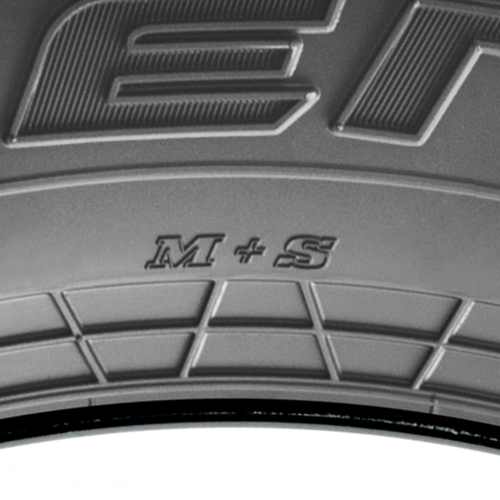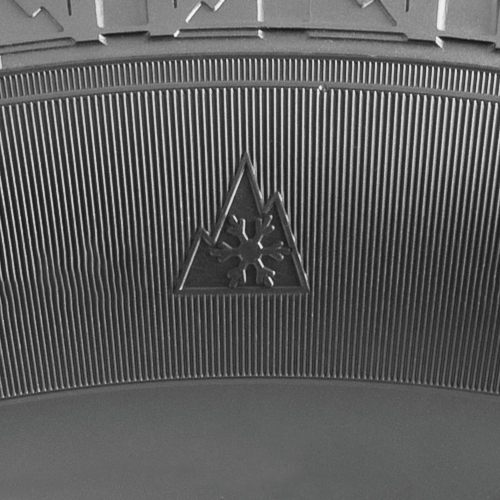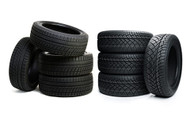Tire Ratings: Three-Peak Mountain Snowflake Vs. M+S Tires
Posted by Agota Szabo on Sep 1st 2022
Tire ratings are important - there is no question about it. There is a clear distinction between winter tires and all season tires. The easiest way to distinguish which tire is which is to look at the tire ratings located on their sidewalls.
Whether there are snowflake on tire sidewalls or the letters M+S determines the weather conditions they can use. Let's take a look at what these tire symbols mean in today's blog post.
All Season Tires with the M+S Rating
Originally, M and S tires were designed to switch out old bias-ply winter tires on vehicles. They have come a long way since then. But, what exactly does the mud and snow tire symbol indicate?
Tires with the mud and snow rating offer good traction in dry, wet, and light winter conditions. They feature wide grooves that prevent mud and snow from blocking the surface contact by packing into the footprint. This significantly increases its performance and traction on versatile terrain and road surfaces.
However, these tires are designed for driving on packed snow or mud. They often lack the necessary number of biting edges to handle ice-covered surfaces. Due to this, it marked its place in the industry as an all season tire symbol.

The Performance of Mud and Snow Tires in True Winter Conditions
The tire icon of "M+S" indicates good performance in light winter conditions when only an inch or two of snow covers the roads. MS tires are perfect for areas where severe conditions do not rule the winter months.
For this reason, they have become associated with all season tires. Their tread designs will not be able to handle harsh winters on their own. They are lacking the needed durability of their compounds to perform in freezing temperatures.
The compound of models with the mud and snow tire rating will literally freeze in temperatures below 40° Fahrenheit, making them not suitable for true winter use.
Severe Snow Service Rated Tires with the Three Peak Mountain Snowflake Symbol
Snow-rated tires feature the 3 mountain snowflake symbol on their sidewalls. These are winter models which are manufactured for true winter weather use. If you are looking for the difference between an all season and a winter tire, this small tire icon will give you an answer.
The secret of three-peak mountain snowflake tires is in their compound blend. These winter tires are manufactured from durable rubber materials that keep their flexibility even in freezing temperatures (below 40° Fahrenheit). In other words, the rubber of tires with snowflake symbol does not freeze.
Additionally, when you see a snowflake tire will feature a heavier siping detail. The small slices on the tread blocks create extra biting edges, enabling the tire's traction on medium-packed snow and ice-covered roads as well. This makes 3PMSF tires safer in winter.

Pushing the Limits of 3PMS Tires
Let's get one thing straight: if you live in areas where harsh winters are a regular occurence, you will need the snowflake on tires. In fact, many Northern US states regulate their use, making it mandatory in certain time periods.
But, how do the 3 peak mountain snow flake tires actually perform in severe winter conditions?
Well, winter snow will not cause an issue. Neither will slush, ice, or freezing temperatures. The tire snowflake symbol indicates that the specific model will be able to securely handle all of this. In theory, this also extends to its controllability, cornering, and braking in such conditions.
These winter tire ratings usually only portray the tires' performing ability on highways. When it comes to off-road winter terrains, vehicle owners might have to invest in snow chains or studded tires. These provide additional traction on ice- and snow-covered conditions, but their use on highways is also regulated.
How do 3 Peak Mountain Snowflake Tires get Certified?
When a model earns the rating, manufacturers place the snowflake symbol on tires. However, there are specific industry standards a tire must meet to earn the triple peak. Hint, it doesn't just take snow traction into account.
In order for a brand to provide the mountain snowflake symbol snow tire ratings to their models, they need to look at the compound. All season tires cannot handle temperatures below 40° Fahrenheit. On the other hand, winter tires feature special compound blends that keep the rubber pliable in freezing temperatures.
Yet, we need to be careful with these tire symbols. It can be used for Light Truck tires which lack the necessary tread details for winter traction, as their compounds meet the industry's standards.

How do M&S Tires Get Certified?
Most all season tires will receive the M+S rating. Actually, there is only one requirement for a tire to receive this symbol. While there are some computer technologies brands can use in order to optimize the tread design, even before the tire is designed and manufactured.
But, let's talk about the necessary tread design. In order for an all season tire to receive the M&S rating, its tread needs to consist of 25% grooves. These grooves are wide enough to disperse mud and snow from between the tread elements while the tires are in motion. This guarantees the tire's secure year-round performance.
Frequently Asked Questions
What Does M+S Mean on a Tire?
The M+S tire rating, or mud and snow symbol, indicates an all season tire. It means that the tire is Mud and Snow rated, showing the tire's capability to provide traction in wet and light winter conditions. Most all season and all weather tires sport the MS tire rating.
What Does 3 Peak Mountain Snowflake Mean on a Tire?
If you see a symbol with 3 mountain peaks and a snowflake on the sidewall of your tires, it means that is it certified for harsh winter conditions. This severe snow service rating basically notes tires that can handle rough winter situations, and ice- and snow-covered roads easily.
















